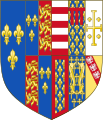Ficheiro:Arms of Margaret of Anjou.svg

Dimensões desta antevisão em PNG do ficheiro SVG: 408 × 477 píxeis Outras resoluções: 205 × 240 píxeis | 410 × 480 píxeis | 657 × 768 píxeis | 876 × 1 024 píxeis | 1 752 × 2 048 píxeis.
Imagem numa resolução maior (ficheiro SVG, de 408 × 477 píxeis, tamanho: 1,41 MB)
Histórico do ficheiro
Clique uma data e hora para ver o ficheiro tal como ele se encontrava nessa altura.
| Data e hora | Miniatura | Dimensões | Utilizador | Comentário | |
|---|---|---|---|---|---|
| atual | 06h05min de 19 de fevereiro de 2015 |  | 408 × 477 (1,41 MB) | Sodacan | fix Bar quarter |
| 11h56min de 5 de agosto de 2013 |  | 408 × 477 (1,43 MB) | Sodacan | size | |
| 11h28min de 5 de agosto de 2013 |  | 408 × 465 (1,43 MB) | Sodacan | sizing | |
| 07h47min de 16 de julho de 2013 |  | 436 × 465 (1,45 MB) | Sodacan | User created page with UploadWizard |
Utilização local do ficheiro
As seguintes 2 páginas usam este ficheiro:
Utilização global do ficheiro
As seguintes wikis usam este ficheiro:
- af.wikipedia.org
- ar.wikipedia.org
- arz.wikipedia.org
- ast.wikipedia.org
- azb.wikipedia.org
- be.wikipedia.org
- bg.wikipedia.org
- ca.wikipedia.org
- cs.wikipedia.org
- da.wikipedia.org
- de.wikipedia.org
- el.wikipedia.org
- en.wikipedia.org
- eo.wikipedia.org
- es.wikipedia.org
- eu.wikipedia.org
- fa.wikipedia.org
- fr.wikipedia.org
Ver mais utilizações globais deste ficheiro.